The AMD Radeon R9 290 Review
by Ryan Smith on November 5, 2013 12:01 AM EST- Posted in
- GPUs
- AMD
- Radeon
- Hawaii
- Radeon 200
Compute
Jumping into pure compute performance, this is another scenario where the 290X shouldn’t throttle as much, and as such the performance differences between the 290 and 290X should be closer to what they are on paper. With compute workloads the ROPs aren’t being hit hard, so that’s power and thermal savings that lets both cards operate at close to their maximum boost clocks.
As always we'll start with our DirectCompute game example, Civilization V, which uses DirectCompute to decompress textures on the fly. Civ V includes a sub-benchmark that exclusively tests the speed of their texture decompression algorithm by repeatedly decompressing the textures required for one of the game’s leader scenes. While DirectCompute is used in many games, this is one of the only games with a benchmark that can isolate the use of DirectCompute and its resulting performance.
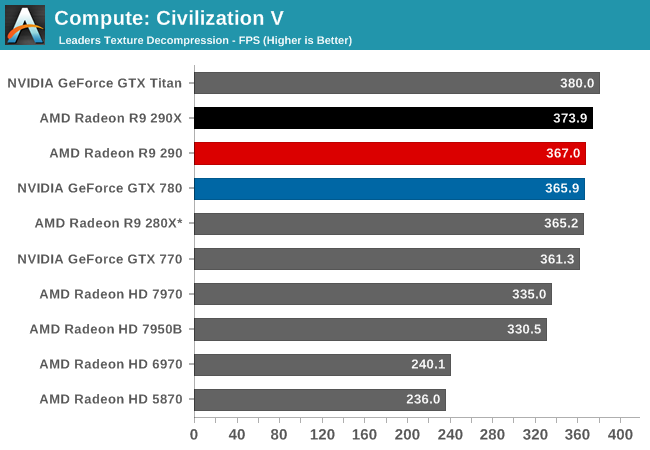
As with the 290X, Civ V can’t tell us much of value due to the fact that we’re running into CPU bottlenecks, not to mention increasingly absurd frame rates. The 290 is marginally slower than the 290X due to the lower clockspeeds and missing CUs, but minimally so.
Our next benchmark is LuxMark2.0, the official benchmark of SmallLuxGPU 2.0. SmallLuxGPU is an OpenCL accelerated ray tracer that is part of the larger LuxRender suite. Ray tracing has become a stronghold for GPUs in recent years as ray tracing maps well to GPU pipelines, allowing artists to render scenes much more quickly than with CPUs alone.
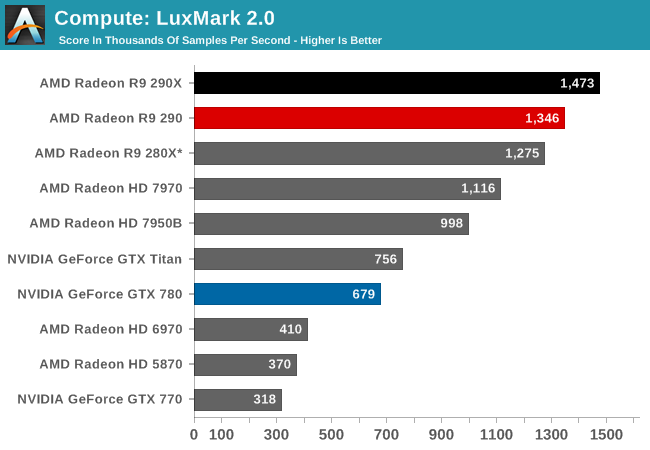
With both cards unthrottled and bound solely by shader performance, it’s an outright foot race for the Radeon cards. 290 trails 290X by around 9%, closely mirroring the difference in the CU count between the two cards. Though 290 is being very closely chased by the 280X, as Hawaii in general seems to have trouble getting the most out of its shader hardware on this benchmark.
Our 3rd compute benchmark is Sony Vegas Pro 12, an OpenGL and OpenCL video editing and authoring package. Vegas can use GPUs in a few different ways, the primary uses being to accelerate the video effects and compositing process itself, and in the video encoding step. With video encoding being increasingly offloaded to dedicated DSPs these days we’re focusing on the editing and compositing process, rendering to a low CPU overhead format (XDCAM EX). This specific test comes from Sony, and measures how long it takes to render a video.
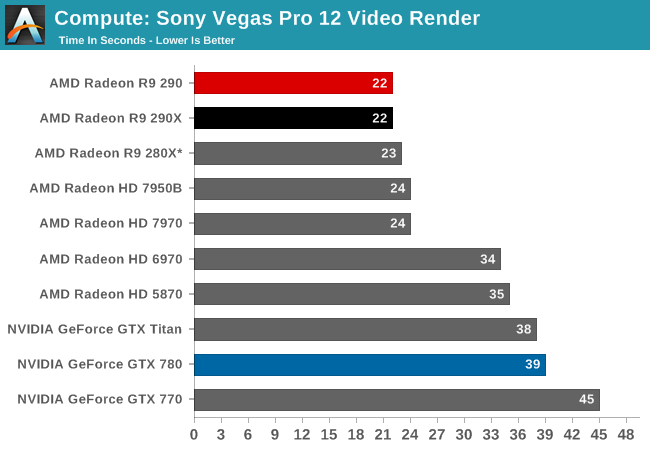
There’s not enough of a GPU performance difference between the two cards to matter with this test. Both tie at 22 seconds.
Our 4th benchmark set comes from CLBenchmark 1.1. CLBenchmark contains a number of subtests; we’re focusing on the most practical of them, the computer vision test and the fluid simulation test. The former being a useful proxy for computer imaging tasks where systems are required to parse images and identify features (e.g. humans), while fluid simulations are common in professional graphics work and games alike.
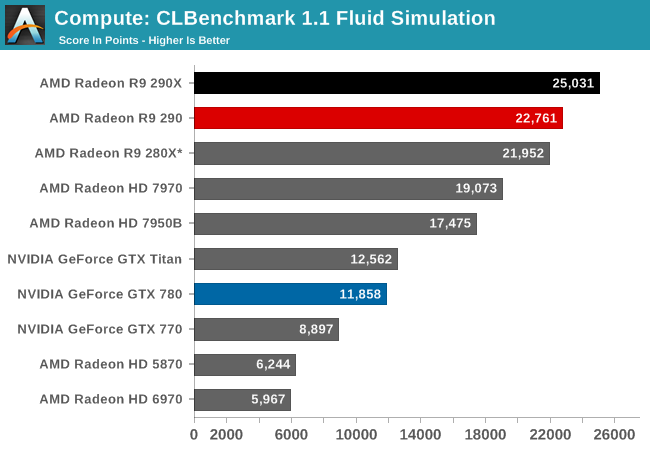

In the CLBenchmark fluid simulation the 290X and 290 take the top spots as expected, with the 290 trailing once more by 9%. However both Hawaii cards are still struggling with the computer vision benchmark, leading to the 290 being edged out by the 7970 of all things.
Moving on, our 5th compute benchmark is FAHBench, the official Folding @ Home benchmark. Folding @ Home is the popular Stanford-backed research and distributed computing initiative that has work distributed to millions of volunteer computers over the internet, each of which is responsible for a tiny slice of a protein folding simulation. FAHBench can test both single precision and double precision floating point performance, with single precision being the most useful metric for most consumer cards due to their low double precision performance. Each precision has two modes, explicit and implicit, the difference being whether water atoms are included in the simulation, which adds quite a bit of work and overhead. This is another OpenCL test, as Folding @ Home has moved exclusively to OpenCL this year with FAHCore 17.
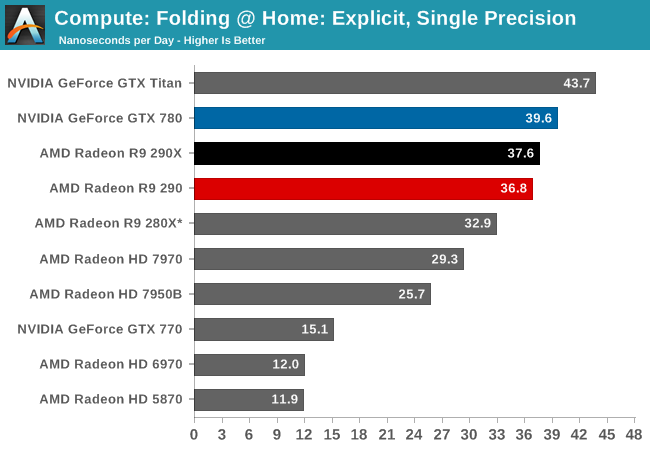
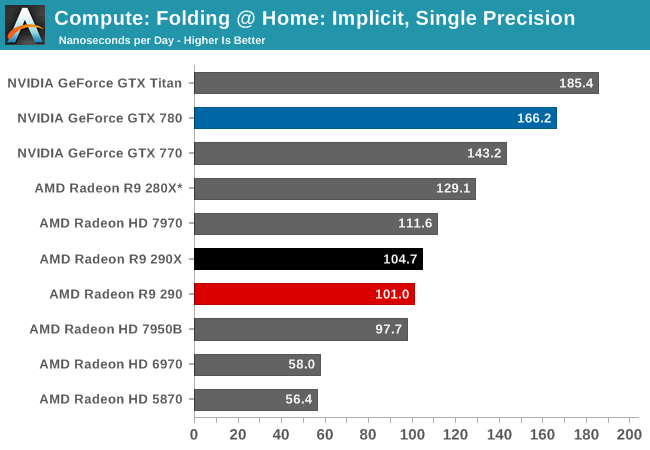
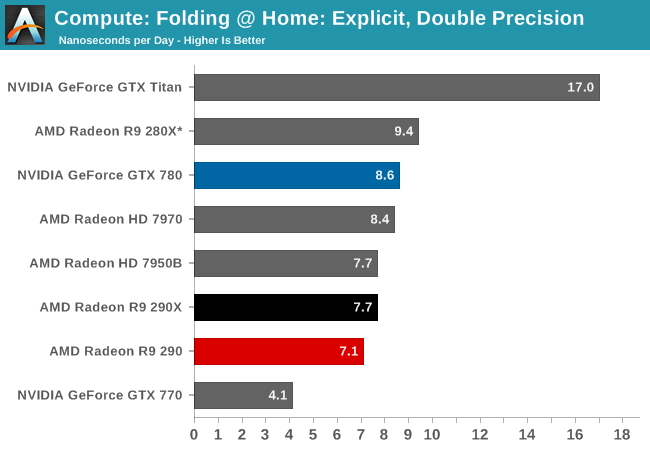
Generally Tahiti and Hawaii are strong performers in the GPU compute arena, but that isn’t of particular help to the 290 here, as it loses out to the GTX 780 in every mode. In single precision FAHBench has trouble putting Hawaii to good use at times, while double precision tests have the 1/8th DP rate 290 and 290X falling behind due to their lower than Tahiti DP throughput.
Wrapping things up, our final compute benchmark is an in-house project developed by our very own Dr. Ian Cutress. SystemCompute is our first C++ AMP benchmark, utilizing Microsoft’s simple C++ extensions to allow the easy use of GPU computing in C++ programs. SystemCompute in turn is a collection of benchmarks for several different fundamental compute algorithms, as described in this previous article, with the final score represented in points. DirectCompute is the compute backend for C++ AMP on Windows, so this forms our other DirectCompute test.
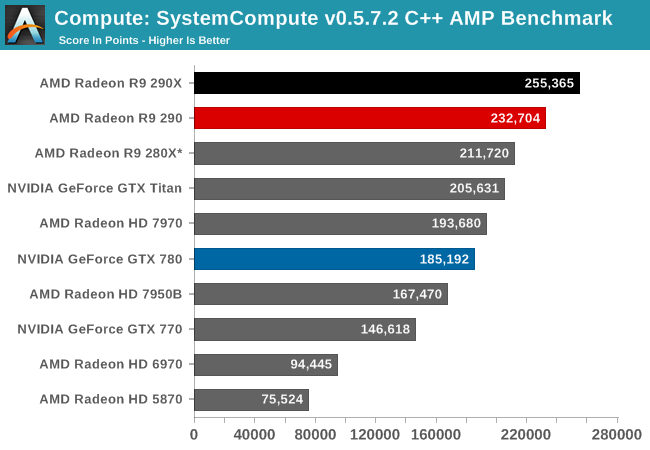
SystemCompute is another benchmark where 290 and 290X do not experience meaningful throttling, and as such are separated by more than what happens in our gaming benchmarks. In this case 290 yet again trails 290X by 9%, though it still enjoys a considerable lead over the GTX 780 and all other NVIDIA cards.










295 Comments
View All Comments
chizow - Tuesday, November 5, 2013 - link
It's really strange what AMD has done with the 290. Sure it has great price and performance, but AMD has also ramped it up in the key complaint areas, power and noise to get there. As a result, the performance of the 290 is close enough to the 290X that you have to wonder if AMD even wants to sell any 290Xs at all. They are hard enough to find to begin with, but at a $150 price difference for ~5% difference in performance, it seems as if AMD is cannibalizing their own SKUs and dissuading people from purchasing the 290X and choosing the much cheaper 290 instead. It also comes close enough to the 280X while thoroughly stomping it to make the 280X seem much less attractive in that $300-$400 range.In the end the 290 seems like a strong buy for anyone who is willing to tolerate the heat and the noise. It's amazing that the 290 is even hotter and louder than the 290X, even taking the crown from the previous high-end, noisy fireball GTX 480 (thanks for including it in these results this time btw). It's certainly possible AMD wants this SKU to sit by itself in that $400 slot, safely away from the 770/280X below it and the GTX 780/290X above it.
dragonsqrrl - Tuesday, November 5, 2013 - link
The GTX480 is not the previous 'noisy fireball'. AMD has introduced many cards since that make the 480 seem downright reasonable. Take the 6990 and 7970GHz for example. AMD has gone so far and beyond Nvidia in terms of heat and noise it seems comical to still hear people talk about the 480 as though it's some kind of benchmark to compare these cards against. The stock coolers on these recent gen high-end cards from AMD have been much louder.HisDivineOrder - Tuesday, November 5, 2013 - link
Everyone who knows anything knows the FX5800 is the benchmark of loud cards. Seriously, that thing was, is, and will always be the Leaf Blower of Legend.That said, the 290 is a very well executed attempt to catch the myth and make real the loud card of lore we once thought dead and gone.
creed3020 - Tuesday, November 5, 2013 - link
LOL, I too remember the term Leaf Blower being used with the FX5800 for the first time. A friend had it in his rig and we couldn't stop bugging him about it. This was coming from another friend who have three 80 mm Antec Tornados in his case!chizow - Tuesday, November 5, 2013 - link
Agreed that the 480 was probably not as loud, it's fan had issues but didn't have the same high pitched whine characteristic of AMD's blowers. But it was the previously hottest, highest power consuming single-GPU and as an owner of 2 in SLI I can say for sure the heat was a lot to deal with.Mariosti - Tuesday, November 5, 2013 - link
Now think about this:290X with new drivers, and proper cooling enabling it not to just "not throttling" but also to get some minor oc. The difference will be much bigger. That's why nvidia must go all the way with GK110 unlocking to make the 780Ti a viable competitor.
TheJian - Tuesday, November 5, 2013 - link
Or NV can just OC their cards until they hit another 10DB or 50-70watts and laugh right? This is all AMD has done. Why didn't AMD just include this magical fan in the ref design? Overclocks show there isn't much in the tank either. Don't forget they're using NV ref here also. You can buy OC cards that are already clocked 10%+ faster out of the box and reviews show they are quiet in comparison which NOBODY buys.jnad32 - Tuesday, November 5, 2013 - link
The way I look at it, AMD is looking like an absolute genius. Everyone was ripping them on the 290X for it being too hot and too loud anyway. So instead of keeping the sound levels down they just went for what they do best, price/performance. They are now blowing every other card out of the water. There isn't a card on the planet that can touch this card in price/performance. Yea its loud as hell but, at least you have to think about it now just because of the price. What I really want to see is them unleash the 290X sound threshold and see what kind of raw numbers it can put up. Lets be honest, the only people who should buy reference cards are the ones who are putting water blocks on them.Dal Makhani - Tuesday, November 5, 2013 - link
hmm seems like this card in a somewhat "uber mode" fan profile cannibalizes AMD's own R9 290X?HanzNFranzen - Tuesday, November 5, 2013 - link
Ok, fine, the reference cooler sucks. But we all know that sooner rather than later there will be several versions with non-reference coolers available. So instead of get 106% of a 780's performance for $100 lees, we will get it for $70 less. (and possibly some more OC headroom?)Any way you slice it, AMD has done a service for all of us enthusiasts no matter if you're an NVidia or AMD fan... The price/performance has come back down to earth. I will be buying one of these cards, no doubt. But I will be waiting to see what Sapphire or Asus come up with as far as cooling or I may just drop for a 3rd party cooler and a reference board.